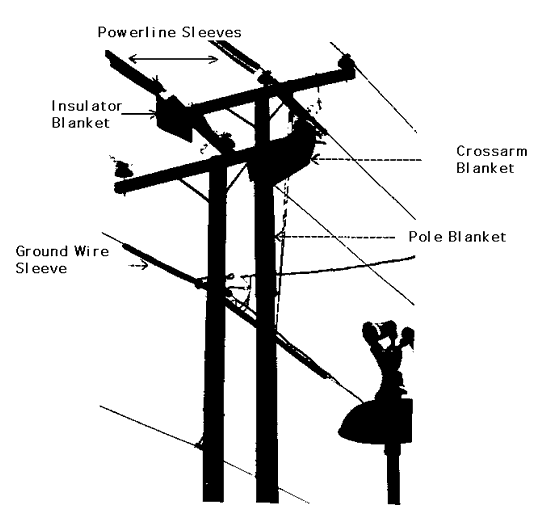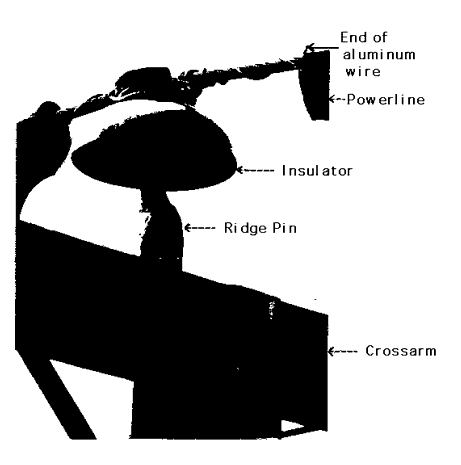Lineman Electrocuted After Contacting Energized Conductor While Working From the Bucket of an Aerial Lift Truck in Virginia
FACE 92-02
SUMMARY
A 35-year-old male lineman was electrocuted after he contacted an energized powerline while working from the bucket of an aerial lift truck. The victim was part of a five-man crew assigned to transfer a three-phase, 34,500-volt, overhead powerline system from one utility pole to a taller utility pole. The transfer of the powerlines had been completed, and insulating blankets and line sleeves still covered the powerlines, insulators, and crossarms. While removing the line sleeve from the middle powerline, the victim's rubber glove became caught on an aluminum wire securing the powerline to the insulator. When the victim pulled his arm back, the rubber glove was partially pulled off, and the victim's exposed right wrist contacted the powerline. Electrical current passed through the victim's right arm and exited the body at the left side of the lower abdomen, which had been in contact with the utility pole crossarm, causing his electrocution. NIOSH investigators concluded that, in order to prevent future similar occurrences, employers should:
- stress the importance of adherence to established safe work procedures
- review and revise, where applicable, safe work procedures regarding the removal of insulating materials, the positioning of aerial buckets, and the procedure used in securing powerlines to insulators.
INTRODUCTION
On September 16, 1991, an electric utility lineman was electrocuted when he contacted an energized powerline while working from the bucket of an aerial lift truck. On September 25, 1991, officials of the Virginia Occupational Safety and Health Administration (VAOSHA) notified the Division of Safety Research (DSR) of this fatality, and requested technical assistance. On November 25, 1991, a DSR safety specialist traveled to the incident site to conduct an investigation. The investigator reviewed the incident with the corporate and construction safety managers, and with the VAOSHA compliance officer assigned to the case. Photographs of the incident site, and a copy of the medical examiner's report were obtained during the investigation.
The employer in this incident was an electrical utility company that had been in operation for 90 years and employed about 13,000 workers, including 1,800 linemen. The company had a written safety policy and written safety rules and procedures which were administered by the managers of the safety department, and by jobsite foremen. A corporate safety department and five divisional safety departments had been established and staffed with safety managers, safety engineers, industrial hygienists, fire safety personnel, and related clerical staff. The company maintained a video training library that covered all aspects of overhead and underground transmission and distribution. Weekly safety meetings were held and documented, and the company promoted safety through the use of written tests, work performance evaluations, communications, and incentive programs. Cardiopulmonary resuscitation and first aid training were mandatory for all field personnel. Also, prior to each job, the company conducted specific tailgate conferences at each job site. The victim had worked for the company for 15 years, including about 8 years as a lineman.
INVESTIGATION
The employer had received a request from a local communications company to install a number of new utility poles which would be 5 feet taller than the existing ones, and to transfer the three-phase, 34,500-volt (phase to phase) overhead powerline onto the new poles. The taller poles would provide additional clearance for the communications company transmission lines.
On the morning of the incident, a pole crew arrived at the job site, erected a taller utility pole about 4 feet away from the existing pole, and moved to the next job site. Later that morning a five-man crew consisting of a job site foreman, two linemen (including the victim), a lead lineman, and a groundsman arrived at the job site to make the transfer of the powerlines. Insulating line sleeves and blankets were positioned over the energized powerlines, ground wire, and insulators, and also over the crossarm attached to the shorter pole. The top section of the taller pole was further protected with an insulating blanket (Figure 1).
The victim proceeded to move the powerlines, one at a time, to the taller pole. First, the middle phase was transferred to an insulator attached to a ridge pin located at the top of the taller pole. An aluminum wire was used to secure the powerline to the insulator. Second, a crossarm was attached to the taller pole and covered with an insulating blanket. Next, the outside phases were transferred, one at a time, to the insulators located on opposite ends of the crossarm, and were secured in place. Finally, the victim began removing the insulating sleeves and blankets.
The line sleeves and insulating blanket were first removed from one of the outside phases. Next, the victim positioned the lip of the bucket next to the crossarm, between the other outside phase and middle phase (Figure 2). The insulating blanket was then removed from the crossarm and middle phase insulator. While trying to remove the middle phase line sleeve, located farthest away from the bucket, the victim's rubber glove became snagged on the aluminum wire which secured the powerline to the insulator (Figure 3). When he pulled his arm back, the rubber glove was pulled partially off, and his exposed right wrist contacted the powerline. Current passed through the victim's right arm and exited the body at the lower abdomen on the left side where he was in contact with the crossarm attached to the utility pole.
Although the incident was unwitnessed, the other crew members heard a buzzing sound, looked up toward the victim, and saw him slump down into the bucket. The groundsman immediately lowered the bucket while another lineman radioed the dispatcher to call the rescue squad. The crew members removed the victim from the bucket and began cardiopulmonary resuscitation. The rescue squad arrived in about 12 minutes, performed advanced cardiac life support, and transported the victim to the local hospital, which was approximately 20 minutes away. The victim was pronounced dead by the emergency room physician 80 minutes after the incident.
CAUSE OF DEATH
The medical examiner's report listed the cause of death as acute cardiac arrhythmia due to electrocution.
RECOMMENDATIONS/DISCUSSION
Recommendation #1: Employers should stress the importance of adherence to established safe work procedures.
Discussion: In addition to requiring the use of personal protective equipment (PPE), established safe work practices required employees to maintain adequate clearance between themselves and objects with ground potential while working with energized powerlines. Work was being performed from an insulated bucket and appropriate PPE was being worn. In addition, the powerlines, insulators, crossarms, and pole top were covered with insulating materials as required by applicable safe work procedures. Although the physical safeguards were being used, clearance from the grounded crossarm was not maintained; this factor allowed the incident to occur. Formulating safe work procedures is only the first step in injury prevention. For safe work procedures to be effective they must be clearly communicated to all employees and supervisors. Supervisors should ensure that established work procedures are followed at all times.
Recommendation #2: Employers should review and revise, where applicable, safe work procedures regarding the removal of insulating materials, the positioning of aerial buckets, and the procedure used in securing powerlines to insulators.
Discussion: Safe work procedures regarding the removal of the insulating blanket from the crossarm before the removal of the line sleeves and insulator blankets should be reviewed and revised, where appropriate. A work procedure which specifies leaving the crossarm insulating blanket in place until after the removal of line sleeves and insulator blankets may help to reduce inadvertent contact with energized conductors. Safe work procedures regarding the positioning and repositioning of the aerial bucket should be periodically reviewed and revised where indicated, to assure the procedure is appropriate in providing access to the middle powerline sleeves, while allowing adequate clearances from ground potential items. The procedure used in securing powerlines to utility pole insulators should be reviewed and revised, where applicable, to ensure the procedure adequately addresses the appropriate manner in which the powerline is secured to the insulator. The tie down (i.e., a piece of wire used to secure the powerline to the insulator), should be fastened to the powerline in such a manner that the ends of the tie down do not protrude from the powerline. This would minimize any snagging hazard.

Figure 1. Insulating Materials

Figure 2. Insulator and Powerline Connection
Return to In-house FACE reports
- Page last reviewed: November 18, 2015
- Page last updated: October 15, 2014
- Content source:
- National Institute for Occupational Safety and Health Division of Safety Research


 ShareCompartir
ShareCompartir